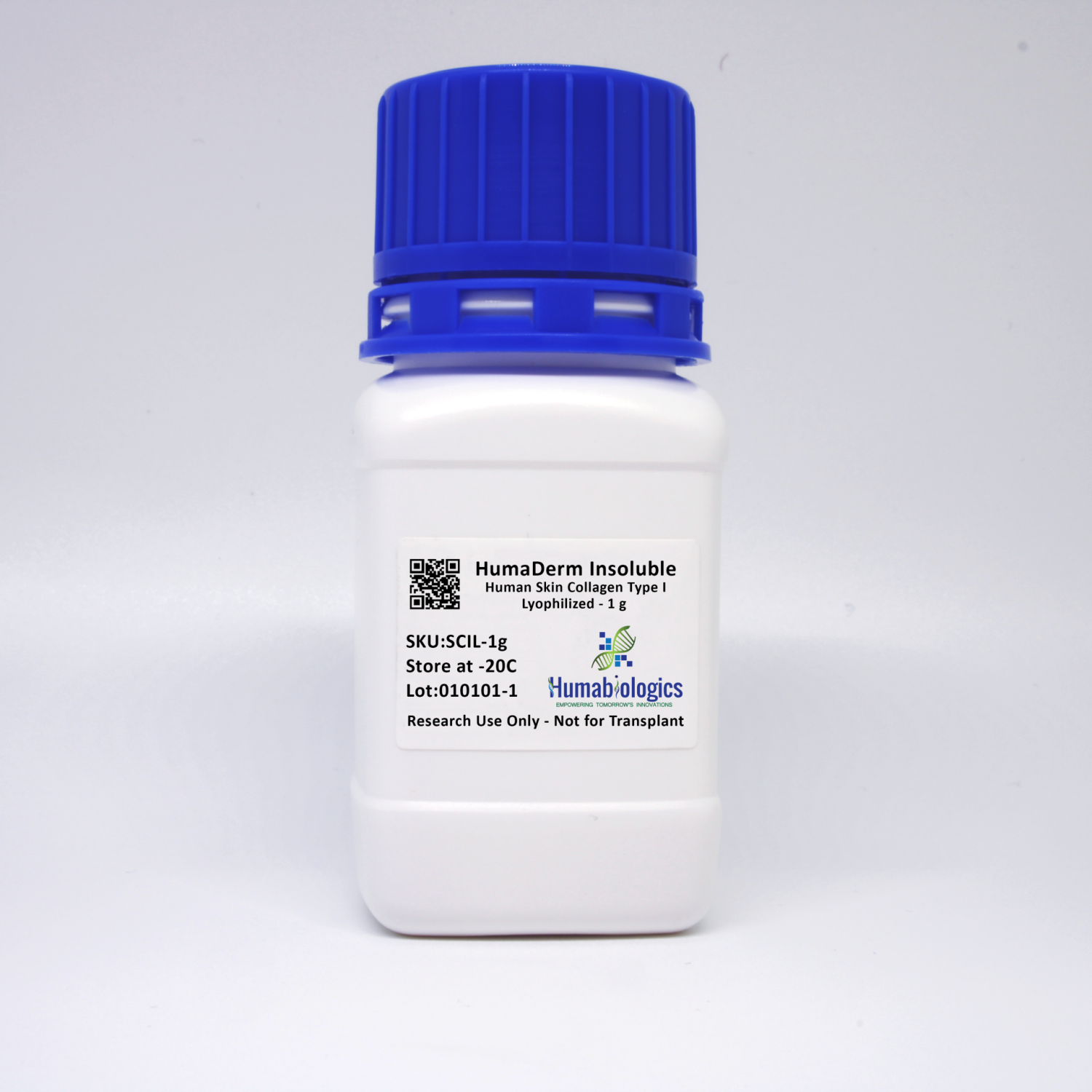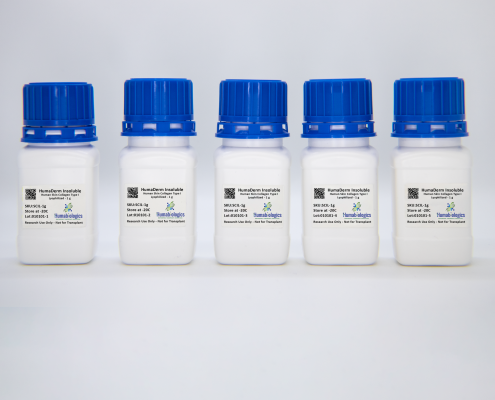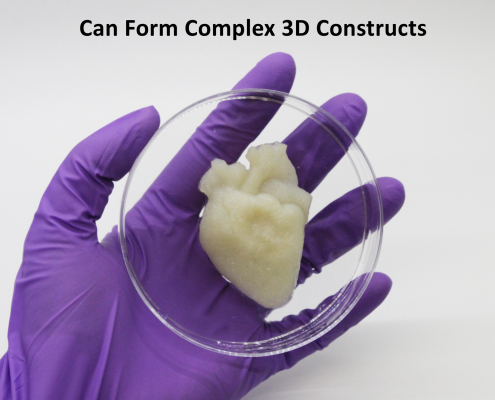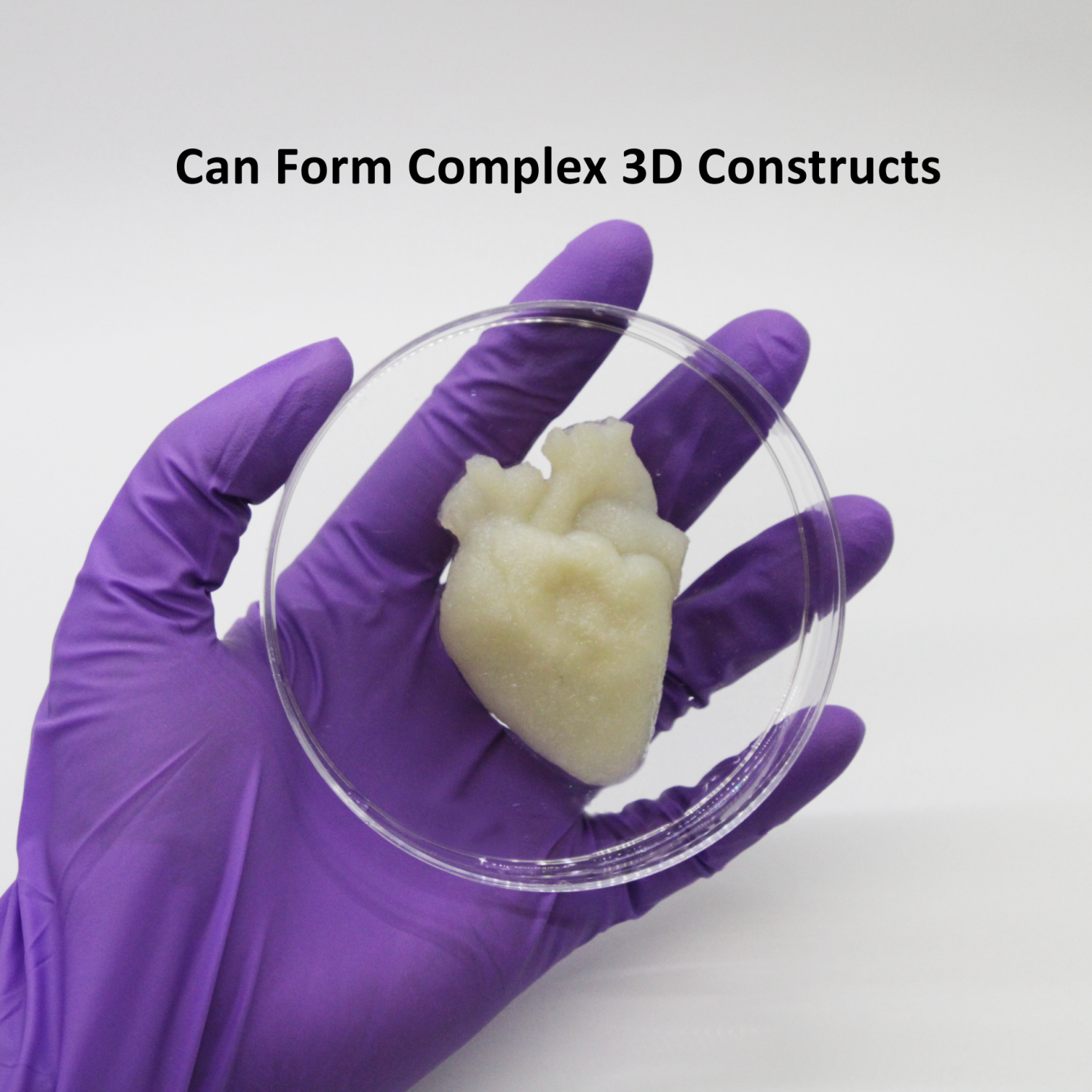HumaDerm® Insoluble
Human Skin Collagen Type I, Lyophilized
SKU: SCIL
HumaDerm® Insoluble is extracted from nutrient-rich human skin tissue sourced strictly from tissue partners who comply with the requirements of transplantable human tissue. HumaDerm® Insoluble is ideal for various tissue engineering applications.
Background
Product Description
Type I Collagen is the most abundant type of collagen in the human body, as a major structural matrix protein in skin, and many other tissues (bone, tendon, and fibrous connective tissues) [1]. There are a number of types of collagen identified to date, and all are composed of molecules containing three polypeptide chains arranged in a triple helical conformation [2]. The types of collagen differ slightly in the primary amino acid sequence of their polypeptide chains. Type I collagen is a heterotrimer composed of one α2(I) chain and two α1(I) chains [3].
Various types of cell surface receptors present on diverse types of mammalian cells recognize the collagen triple helix structure and facilitate cell attachment to collagen materials, including films and scaffolds. The most characterized cell receptors are the integrins α1β1 and α2β1 [4]. Many cell types express both forms of integrin, including mesenchymal stem cells (MSCs), fibroblasts, endothelial cells, chondrocytes, osteoblasts, and lymphocytes[3, 5-7]. Smooth muscle cells interact with collagen via α1β1, and epithelial cells attach via α2β1 [8, 9]. Collagen type I is characterized by the presence of three regions on SDS-PAGE corresponding to molecular weights. The alpha region has a molecular weight of 100 KDa and consists of two α1 chains and one α2 chain. The beta region has a molecular weight of 200 KDa and consists of two α1 chains fused together and α1 α2 chains fused together. The gamma region has a molecular weight of 300 KDa and consists of overlapping two α1 and one α2 chains. HumaDerm® has all three regions and chains with very minimal fragmented proteins in between. HumaDerm® is ideal for many applications including coating tissue culture surfaces to support cell attachment and growth or for making hydrogel.
Tissue Source
Type I collagen is isolated from human skin sourced strictly from American Association of Tissue Banks (AATB) accredited and FDA registered tissue banks and organ procurement organizations (OPOs). Humabiologics® strives to meet research needs by providing high quality biomaterials obtained from tissue partners who comply with requirements for transplantable human tissues under 21 CFR 1271 of the Food and Drug Administration (FDA).
Precautions and Disclaimer
HumaDerm® is obtained from human tissue that has been tested and found negative for a minimum of HIV-1 and -2, hepatitis B, and hepatitis C, as well as other infectious agents. Please review the Safety Data Sheet (SDS) for information regarding hazards and safe handling practices. HumaDerm® is for research use only and is not intended for human use, diagnosis, screening, household, food or other uses.
Storage
HumaDerm® Insoluble should be stored at -20 °C upon receipt. Collagen is a stable protein if it is stored frozen while minimizing freeze-thaw cycles. Research grade products have a shelf life of 6 months upon receipt.
References
1. Bornstein, P. and H. Sage, Structurally distinct collagen types. Annu Rev Biochem, 1980. 49: p. 957-1003.
2. Tanzer, M.L., Cross-linking of collagen. Science, 1973. 180(4086): p. 561-6.
3. Heino, J., The collagen family members as cell adhesion proteins. Bioessays, 2007. 29(10): p. 1001-10.
4. Barczyk, M., S. Carracedo, and D. Gullberg, Integrins. Cell Tissue Res, 2010. 339(1): p. 269-80.
5. Heino, J., The collagen receptor integrins have distinct ligand recognition and signaling functions. Matrix Biol, 2000. 19(4): p. 319-23.
6. Ivaska, J., et al., Cell adhesion to collagen. Is one collagen receptor different from another? Vol. 30. 1998. 273-283.
7. Goessler, U.R., et al., In vitro analysis of integrin expression in stem cells from bone marrow and cord blood during chondrogenic differentiation. J Cell Mol Med, 2009. 13(6): p. 1175-84.
8. Ebert, E.C. and A.I. Roberts, Human intestinal intraepithelial lymphocytes bind to mucosal mesenchymal cells through VLA4 and CD11A. Cell Immunol, 1996. 167(1): p. 108-14.
9. Gilcrease, M.Z., Integrin signaling in epithelial cells. Cancer Lett, 2007. 247(1): p. 1-25.
Instructions for Use
HumaDerm® Insoluble – Suggested Instructions for Use
Note: The following are general recommendations. Researcher should optimize parameters based on their specific applications. Hydrating in 10-20 mM HCl will change solution viscosity and help with homogenization.
- Weigh out desired amount of insoluble collagen.
- Hydrate collagen to cold water.
- Mix the collagen solution until the collagen is fully hydrated.
- Bring the solution to a homogenous form. Ensure that the temperature stays less than 30 °C during the homogenization process.
- Remove bubbles through quick centrifuge.
- The solution can then be used as needed or frozen and lyophilized to form a scaffold.
Quality Testing
| Test | Specification |
|---|---|
| Appearance (form) | |
| Color | White |
| Form | Fibrous Flaky Material |
| Purity alpha, beta and gamma regions with α1 & α2 chains |
>95% |
| Immunology/Serology Testing** | |
| HBV | Non-Reactive |
| HCV | Non-Reactive |
| HIV-1 | Non-Reactive |
| HIV-2 | Non-Reactive |
| RPR-Syphilis | Non-Reactive |
* Gel data is available upon request
** Testing was done using FDA approved kits in CLIA certified lab
*** Donor info is available upon request
Publications
Safety Data Sheet






